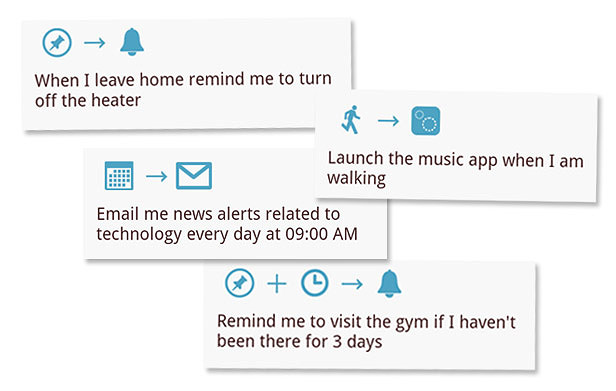An App to Automate Life’s Little Tasks

Sure, you can text your significant other that you’re on the way home when you leave the office, or turn music on when you go for a run. But wouldn’t it be easier if your phone did it for you?
A new, free app and accompanying website from Microsoft’s Bing search engine purports to do just that. Released in a public beta version this week, on{X} lets users set up so-called “recipes” that their smart phone will adhere to, performing preset tasks under specific conditions by using the various sensors and capabilities that are built into the device.
You might, for example, add a recipe that orders your phone to show you a weather forecast every morning at 7 if that day’s expected temperature is below 50 degrees; or a recipe that has your phone remind you to water your plants when you get home. You can also set up recipes that deal with the absence of an activity, like directing your phone to remind you to go to the gym if you haven’t been there for three days.
Tech-minded users can program their own rules with on{X}’s JavaScript API and share them with others; if you’re not a coder, you can also choose from several ready-made rules on the site and modify them to your liking.
As Stefan Weitz, Bing’s senior director, concedes, the idea isn’t really new: The Website ifttt (“if this then that”) has long allowed users to set online tasks using specific triggers, like saving a copy of every photo you upload to Instagram. There’s also an Android app called Tasker, which, for $6.49, lets users automate numerous tasks, such as putting your phone in silent mode when you arrive at work.
Yet Weitz says that in addition to taking advantage of a phone’s sensors and allowing users to code their own rules, on{X} draws on Bing’s investments in search. If you set up the aforementioned weather rule or one that e-mails you the top tech headlines every morning, for example, on{X} performs a search to bring you the requested information.
“[People] should expect more from search going forward—get out of the mode of thinking it’s just a search box into which they need to input a keyword,” he says.
The app is currently available only for phones that run Google’s Android software; Weitz says a Windows Phone version is also in the works, though he has no details on whether an app may be forthcoming for Apple’s iPhone.
Chris Silva, a mobile analyst at Altimeter Group, says that with about half of U.S. cell-phone users now toting smart phones and the popularity of interactive software and devices like Apple’s Siri voice-recognition software and Microsoft’s motion-sensing Kinect device, the time is right for something like on{X} to become a mass-market tool.
“The smart phone is starting to go the route of the in-home telephone or the TV, which says to me, ‘All right, what else can we do with these things?’ ” he says.
Silva thinks developers will play around with on{X} initially, coding rules that will be adopted as less tech-minded users gravitate to the service. He can see it being useful for automating business-related tasks, or for making your phone “smarter” when you’re driving.
It’s clear that the fledgling service has a ways to go, though. Currently, much of the on{X} experience takes place in a Web browser: You can only add, modify, or code rules from the website. The mobile app allows you to delete or turn off rules, or view the activity log related to individual rules.
Still, Weitz thinks users will be drawn to on{X}, since we’ve long desired the kind of automated intelligence that can alert us in the morning if it will be a cold day.
“That’s one of those tiny things that’s really powerful, if you think about it,” he says.
Keep Reading
Most Popular
Large language models can do jaw-dropping things. But nobody knows exactly why.
And that's a problem. Figuring it out is one of the biggest scientific puzzles of our time and a crucial step towards controlling more powerful future models.
The problem with plug-in hybrids? Their drivers.
Plug-in hybrids are often sold as a transition to EVs, but new data from Europe shows we’re still underestimating the emissions they produce.
Google DeepMind’s new generative model makes Super Mario–like games from scratch
Genie learns how to control games by watching hours and hours of video. It could help train next-gen robots too.
How scientists traced a mysterious covid case back to six toilets
When wastewater surveillance turns into a hunt for a single infected individual, the ethics get tricky.
Stay connected
Get the latest updates from
MIT Technology Review
Discover special offers, top stories, upcoming events, and more.